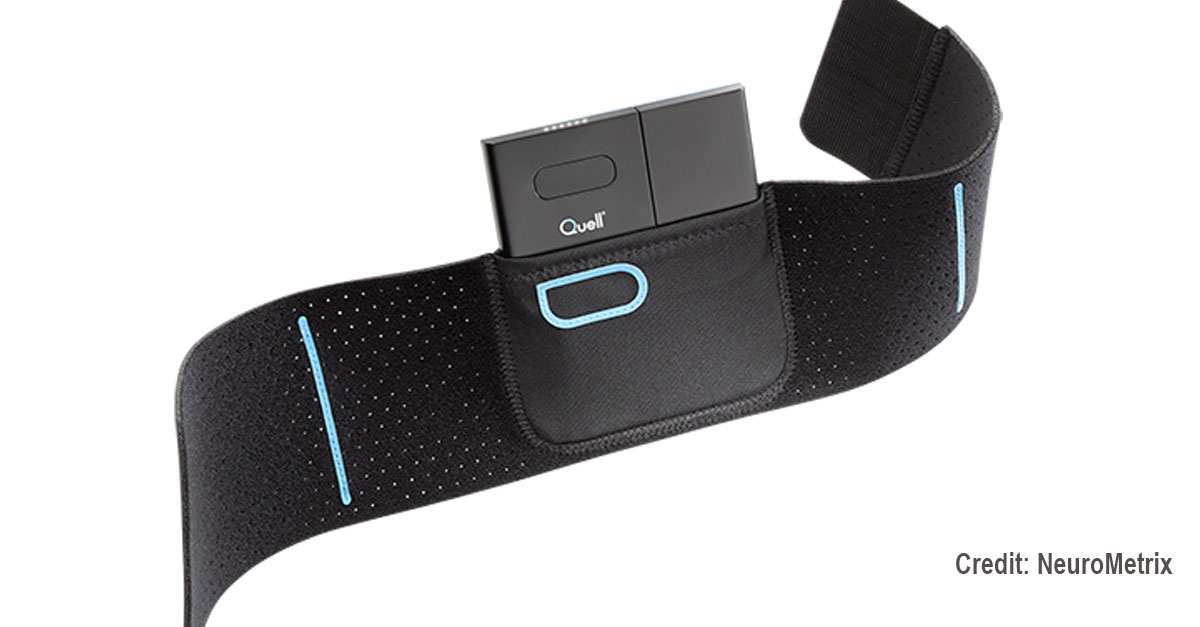Chronic pain can be insidious. But what if you could relieve chronic pain almost anywhere in your body just by wearing a discreet band on your leg?
There is a new product on the market that makes that claim—and believe it or not, it has received FDA approval.
Anytime there’s a way for our readers to get help with chronic pain that doesn’t involve dangerous painkilling drugs or other risky or unproven methods, we’re all over it. So we took a good look at this product.
It’s called Quell, and it’s a band that you strap around your lower leg to stop pain you’re feeling in your neck, back, shoulder and elsewhere on your body (although it doesn’t work for headaches). The device, designed by researchers from MIT and Harvard, has been approved by the Food and Drug Administration as a medical device that can be sold to the public without a prescription for relief of chronic pain. It can be used while you’re awake and/or while you’re sleeping.
Gary Kaye, the founder and chief content officer of Tech50+, a website that covers consumer electronics–related topics for people over age 50, called our attention to the new device. “It’s very good for people who have chronic pain. Of course, it won’t ameliorate the condition that may be causing your pain, but it can reduce the pain you feel.” (Kaye has no financial stake in this or any of the devices he reviews.)
AN ESTABLISHED TREATMENT
The basic technology underlying the Quell device has been around for decades—transcutaneous electrical nerve stimulation (TENS). If you’ve had physical therapy, you may have had TENS—tiny electrodes attached to your body and hooked up to a battery pack deliver a tingling sensation. These neural pulses are believed to release natural brain chemicals that block pain signals.
While TENS doesn’t work for every patient, studies show that it can relieve pain in many people with conditions such as chronic low back pain, neuropathy (nerve pain) and fibromyalgia. A recent meta-analysis of randomized clinical studies found strong evidence that TENS is more effective than placebo for chronic musculoskeletal pain and moderate evidence that it is effective for neuropathy. “In addition,” the report said, “the general consensus from clinical experience is that TENS helps patients to manage their pain.”
HONEY, THEY SHRUNK THE PT MACHINE
With Quell, the technology has been adapted and miniaturized so you can wear it. You strap the band, which contains electrodes, on your calf, adjust it so that it’s the right level of tingling for you, and then set it so that it goes on for an hour at a time, followed by an hour off.
You can use it for just an hour or set it for near-continuous use, with a sleep cycle that’s a lower intensity so it doesn’t wake you up. There’s an accompanying Bluetooth app that lets you use a smartphone or tablet to track both your pain—and your sleep, since there is such a close relationship between pain and sleep quality. Quell’s battery lasts up to 40 hours, which, since it’s used only every other hour, is good for a few days. It takes about three hours to recharge.
SHOULD YOU TRY IT?
Because the FDA approved Quell based on the efficacy of the underlying TENS technology, the company didn’t need to submit independent studies showing that the Quell device itself is effective. But an earlier version called Sensus was tested with physicians who used it on their chronic-pain patients, and more than 50% of the patients were still using it six months later, a sign that they were getting relief. According to the company, two-thirds of Quell users take less pain medication and 81% report an improvement in chronic pain. The company also offers a 60-day money-back guarantee in case Quell doesn’t work for you. That said, it would be preferable if there were published, peer-reviewed studies of the new device.
If you decide to give it your own personal trial, let your doctor know—especially if you are being treated for a chronic pain condition. That way, you can monitor your progress together and work out any issues as you attempt to reduce your use of pain medications. While this nerve stimulation is generally safe and without significant side effects—one reason the FDA has approved it for use without prescription—it should not be used if you have a cardiac pacemaker, implanted defibrillator or any other implanted metallic or electronic device…if you are prone to seizures…or if you are pregnant. (Nor does it work for every kind of pain, such as migraine pain, although there’s another wearable device for that, Cefaly.)
The cost, which at present is not covered by insurance, is about $250 for the device—plus about $30 a month for replacement electrodes. You can learn more at Quellrelief.com.
If you try it, leave a comment and let us know how it goes.
Not a gadget type? Get more tips in Bottom Line’s “Guide to Drug-Free Back Pain Relief.”
[button content=”NEXT: SHOCKING BUT EFFECTIVE” color=”orange” text=”black” url=”https://bottomlineinc.com/transcutaneous-electrical-nerve-stimulation-tens-helps-neuropathy-patients/?utm_source=Organic&utm_medium=cta&utm_campaign=DM_ENGAGEMENT_NEUROPATHY_2016_06_24″ openin=”_self”]


